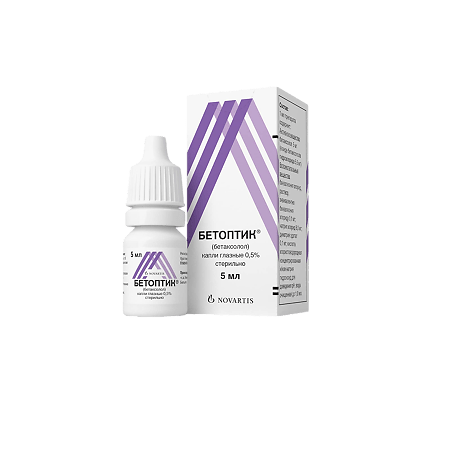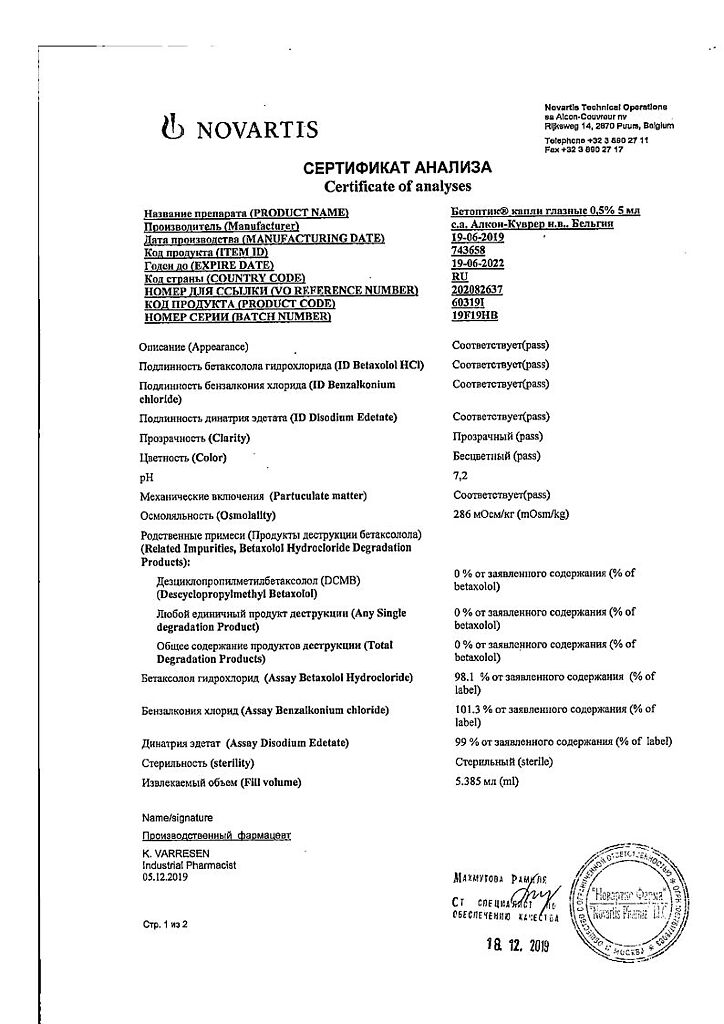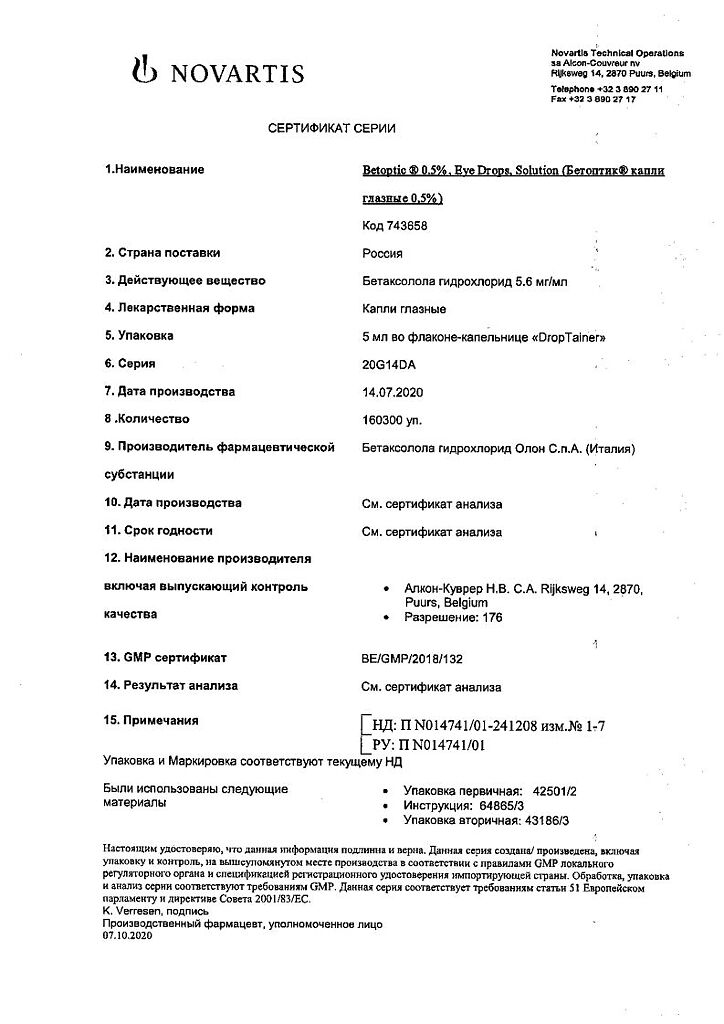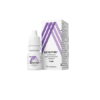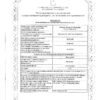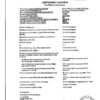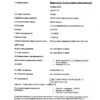No products in the cart.
Betoptik, eye drops 0.5% 5 ml
€15.32 €12.76
Description
Betaxolol is a selective beta 1 -adrenoblocker without intrinsic sympathomimetic activity. It has no membrane stabilizing (local anesthetic) effect.
Betaxololol reduces intraocular pressure by reducing intraocular fluid production when used topically.
The onset of hypotensive effect is observed 30 min after injection, the maximum effect occurs after 2 h. After single instillation the effect on ophthalmotonus lasts for 12 hours.
Betaxolol (in comparison with other beta-adrenoblockers) does not cause reduction of blood flow in the optic nerve.
Betaxolol does not cause myosis, accommodation spasm, hemeralopia, the effect of “shrouds” in front of the eyes (unlike myotics).
Pharmacokinetics
Betaxololol is highly lipophilic, resulting in good penetration through the cornea into the anterior chamber, C max in the anterior chamber is determined 20 minutes after instillation. When applied topically, systemic absorption is low, with plasma concentrations below the threshold (2 ng/ml) of detection.
The excretion is mainly through the kidneys.
Indications
Indications
The drug is used to reduce intraocular pressure as monotherapy or in combination with other drugs for:
Open angle glaucoma.
Ocular hypertension.
Betoptic can be used to treat open-angle glaucoma or ocular hypertension in patients with diseases of the respiratory system.
Pharmacological effect
Pharmacological effect
Betaxolol is a selective beta 1-blocker without intrinsic sympathomimetic activity. Does not have a membrane-stabilizing (local anesthetic) effect.
When applied topically, betaxolol reduces intraocular pressure due to a decrease in the production of intraocular fluid.
The onset of the hypotensive effect is observed 30 minutes after instillation, the maximum effect develops after 2 hours. After a single instillation, the effect on ophthalmotonus persists for 12 hours.
Betaxolol (compared to other beta-blockers) does not cause a decrease in blood flow in the optic nerve.
Betoptik does not cause miosis, accommodation spasm, hemeralopia, or a “veil” effect before the eyes (unlike miotics).
Pharmacokinetics
Betaxolol is highly lipophilic, as a result of which it penetrates well through the cornea into the anterior chamber, Cmax in the anterior chamber is determined 20 minutes after instillation. When applied topically, systemic absorption is low, plasma concentrations below the threshold (2 ng/ml) of detection.
Excretion is primarily through the kidneys.
Special instructions
Special instructions
Diabetes mellitus
Beta-blockers should be prescribed with caution to patients with a predisposition to hypoglycemia, since these drugs may mask the symptoms of acute hypoglycemia.
Thyrotoxicosis
Beta blockers may mask some symptoms of hyperthyroidism (eg, tachycardia). In patients with suspected thyrotoxicosis, beta-blockers should not be abruptly discontinued, as this may cause an increase in symptoms.
Muscle weakness
Beta blockers may cause symptoms similar to those of myasthenia gravis (eg, diplopia, ptosis, general weakness).
Surgery
Before a planned operation, beta-blockers should be gradually (not all at once!) withdrawn 48 hours before general anesthesia, because during anesthesia, they can reduce the sensitivity of the myocardium to sympathetic stimulation necessary for cardiac function.
Pulmonology
Caution should be exercised when prescribing beta-blockers to patients with severe respiratory failure. Despite the fact that clinical studies have shown no effect of betaxolol on respiratory function, the possibility of hypersensitivity to the drug should not be excluded.
Risk of developing an anaphylactic reaction
Patients taking beta-blockers may have a history of atopy or anaphylactic reactions. In case of repeated reactions, such patients may not be sensitive to the usual doses of adrenaline (epinephrine) needed to relieve anaphylaxis.
The drug should be used with caution in patients with Raynaud’s syndrome and pheochromocytoma. When administered locally, beta blockers can enter the systemic circulation and have the same side effects as when administered systemically. Cases of severe respiratory and cardiovascular disorders have been described, including death from bronchospasm in patients with bronchial asthma and death from heart failure.
Betoptic C has a minimal effect on blood pressure and heart rate. However, caution should be exercised when prescribing it to patients with satrioventricular block or heart failure. Treatment should be stopped when the first signs of decompensation of the cardiovascular system appear.
The drug contains the preservative benzalkonium chloride, which can be absorbed by contact lenses (soft). Before using the drug, the lenses should be removed and put back no earlier than 20 minutes after using the drug.
Do not touch the tip of the dropper bottle to any surface to avoid contamination of the dropper bottle and its contents. The bottle must be closed after each use.
Impact on the ability to drive vehicles and operate machinery
Patients whose vision clarity is temporarily reduced after instillation of the drug are not recommended to engage in activities that require increased attention and reaction until it is restored.
Active ingredient
Active ingredient
Betaxolol
Composition
Composition
Eye drops 0.5% in the form of a clear, colorless or slightly yellowish solution.
1 ml betaxolol hydrochloride 5.6 mg, which corresponds to the content of betaxolol 5 mg
Excipients:
benzalkonium chloride,
hydrochloric acid and/or sodium hydroxide solution (to maintain pH level),
purified water.
Pregnancy
Pregnancy
There is no sufficient experience with the use of Betoptik during pregnancy and breastfeeding.
It is possible to use Betoptik for the treatment of pregnant and nursing mothers as prescribed by the attending physician, if the expected therapeutic effect exceeds the risk of developing possible side effects.
Contraindications
Contraindications
Individual hypersensitivity to the components of the drug.
Sinus bradycardia.
AV block II and III degrees.
Cardiogenic shock.
Severe heart failure.
Children under 18 years of age.
Side Effects
Side Effects
Local
Transient discomfort in the eyes, blurred vision, pinpoint keratitis, decreased sensitivity of the cornea, sensation of a foreign body in the eye, photophobia, lacrimation, itching, burning, dry eyes, redness of the eyes, anisocoria, pain in the eye, decreased visual acuity, allergic reactions.
From the side of the central nervous system
Dizziness, nausea, drowsiness, insomnia, headache, depression, increased symptoms of Myasthenia gravis.
From the cardiovascular system
Bradycardia, cardiac conduction disturbances and heart failure.
From the respiratory system
Dyspnea, bronchospasm, bronchial asthma, respiratory failure.
Systemic side effects are rare.
Interaction
Interaction
In patients receiving Betoptic S eye drops and concomitantly taking other beta-blockers orally, the risk of side effects (both systemic and local) may be higher due to a possible additive effect. Such patients should be under close medical supervision.
When combined with drugs that deplete catecholamines, increased effects such as decreased blood pressure and bradycardia may occur.
With the simultaneous administration of muscle relaxants and hypoglycemic agents, an increase in their effect may be observed.
When used together with sympathomimetics, their vasoconstrictor effect is enhanced.
Caution should be exercised when using betaxolol and adrenergic psychotropic drugs together due to the possible enhancement of their effect.
With the simultaneous use of betaxolol and drugs that affect atrioventricular conduction (such as quinidine antiarrhythmics, amiodarone, cardiac glycosides, calcium channel blockers, parasympathomimetics), an additive effect may develop – bradycardia, atrioventricular block, arterial hypotension.
If necessary, can be used in combination with other local ophthalmic drugs. In this case, the interval between their use should be at least 10 minutes.
Overdose
Overdose
If excess amounts of the drug get into your eyes, rinse your eyes with warm water.
Storage conditions
Storage conditions
Store at temperatures from 8° to 30°C out of the reach of children.
Shelf life
Shelf life
3 years.
Manufacturer
Manufacturer
Alcon-Couvreur, Belgium
Additional information
| Shelf life | 3 years. |
|---|---|
| Conditions of storage | Store at temperatures from 8 ° to 30 ° C in places out of the reach of children. |
| Manufacturer | Alcon-Couvreur, Belgium |
| Medication form | eye drops |
| Brand | Alcon-Couvreur |
Related products
Buy Betoptik, eye drops 0.5% 5 ml with delivery to USA, UK, Europe and over 120 other countries.

